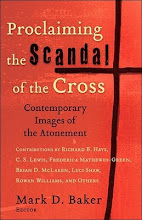
In the March 5 issue of TIME, Jon Meacham offers an interesting take on faith (Christianity in particular) and politics ("A Time to Compromise"). He writes,
". . . The ferociously religious are doing religion no favors at the moment, and it's beginning to feel as though we may need to save faith from the extreme pronouncements of the faithful. Believers should remember that when he was on trial before Pontius Pilate, Jesus said his kingdom was not of this world. It still isn't."
I agree with Meacham, if what he means by "it still isn't" is that the kingdom to which Jesus refers does not have its origins among the kingdoms of the world. It's not that the kingdom of God is of another world or sphere (like Mars or Heaven), but rather that it does not share, at its heart, a competitive commonality with other kingdoms.
At the time when Pilate was interrogating Jesus (see John 18), the power and domination of the Roman Empire was a present reality. That empire shared much in common with other empires (like the Babylonians and Persians who came before): Domination, acquisition, and forced acculturation. Jesus, however, says that his kingdom does not originate with the others.
Jesus proclaimed the present and impending reality of God's kingdom by teaching through parables and explaining how different God was from the characterizations of the religious elite. He demonstrated the authenticity of the kingdom by casting out demons, raising the dead, and healing the sick. In both proclamation and demonstration he showed that the kingdom of God is like no other. The kingdom of God brings the desires and intentions of God to bear in the real world, deflating the power of evil and death. Yes, there is power in this kingdom, but not the kind that is seen in other kingdoms. It is the power to set all things right, and not just in one country.
I wonder if we American Christians are getting this mixed up. There's too much rhetoric out there that suggests that the kingdom of America (as some wish it would be) is somehow concurrent with the kingdom of God. But America, as unique and fine a place as it can be, is still a kingdom of this world. The kingdom of God transcends all kingdoms, including this one.
We don't help our country by either hating it or deifying it. We help it by seeing it clearly, warts and all. We who follow Jesus also proclaim and demonstrate the reality of God's kingdom when we live faithfully, speak truthfully, care compassionately, and suffer willingly. Political power and domination are not our missions in the world, but they are the context in which we live out the realities of God's kingdom.
When Catholics and Evangelicals are reduced to a voting block; when Christianity is viewed as a religious philosophy that must be forcibly injected into society; when the language of power and control replace the words of compassion and justice; then we may have mixed up our kingdoms. And calling the work of God something that it isn't is to stand on dangerous ground. It should be sacred ground that we seek.
The kingdom of God may not be of this world, but it is still at hand.
God help us.

































